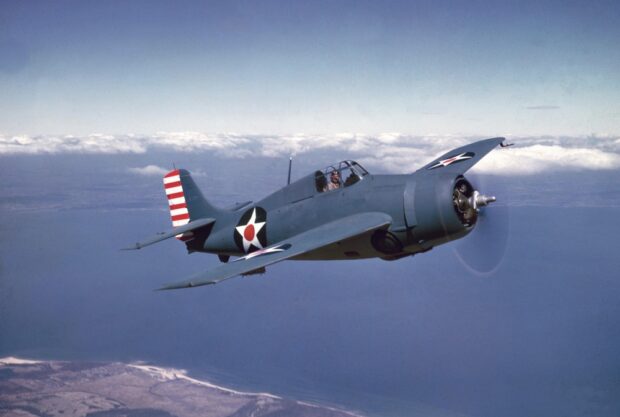The Grumman F4F Wildcat is an American carrier-based fighter aircraft that entered service in 1940 with the United States Navy, and the British Royal Navy where it was initially known as the Martlet. First used by the British in the North Atlantic, the Wildcat was the only effective fighter available to the United States Navy and Marine Corps in the Pacific Theater during the early part of the Second World War.
The disappointing Brewster Buffalo was withdrawn in favor of the Wildcat and replaced as aircraft became available.
With a top speed of 318 mph (512 km/h), the Wildcat was outperformed by the faster (331 mph (533 km/h)), more maneuverable, and longer-ranged Mitsubishi A6M Zero. US Navy pilots, including John “Jimmy” Thach, a pioneer of fighter tactics to deal with the A6M Zero, were greatly dissatisfied with the Wildcat’s inferior performance against the Zero in the battles of the Coral Sea and Midway.The Wildcat has a claimed air combat kill-to-loss ratio of 5.9:1 in 1942 and 6.9:1 for the entire war.
Lessons learned from the Wildcat were later applied to the faster F6F Hellcat. While the Wildcat had better range and maneuverability at low speed, the Hellcat could rely on superior power and high speed performance[8] to outperform the Zero. The Wildcat continued to be built throughout the remainder of the war to serve on escort carriers, where the larger and much heavier Hellcat could not be used.
Design and development
Grumman fighter development began with the two-seat Grumman FF biplane. The FF was the first U.S. naval fighter with a retractable landing gear. The wheels retracted into the fuselage, leaving the tires visibly exposed, flush with the sides of the fuselage. Two single-seat biplane designs followed, the F2F and F3F, which established the general fuselage outlines of what would become the F4F Wildcat. In 1935, while the F3F was still undergoing flight testing, Grumman started work on its next biplane fighter, the G-16. At the time, the U.S. Navy favored a monoplane design, the Brewster F2A-1, ordering production early in 1936. However, an order was also placed for Grumman’s G-16 (given the navy designation XF4F-1) as a backup in case the Brewster monoplane proved to be unsatisfactory.
It was clear to Grumman that the XF4F-1 would be inferior to the Brewster monoplane, so Grumman abandoned the XF4F-1, designing instead a new monoplane fighter, the XF4F-2. The XF4F-2 would retain the same, fuselage-mounted, hand-cranked main landing gear as the F3F, with its relatively narrow track. The unusual manually-retractable main landing gear design for all of Grumman’s U.S. Navy fighters up to and through the F4F, as well as for the amphibious Grumman J2F utility biplane, was originally created in the 1920s by Leroy Grumman for Grover Loening. Landing accidents caused by failure of the main gear to fully lock into place were distressingly common.
The overall performance of Grumman’s new monoplane was felt to be inferior to that of the Brewster Buffalo. The XF4F-2 was marginally faster, but the Buffalo was more maneuverable. The Buffalo was judged superior and was chosen for production. After losing out to Brewster, Grumman completely rebuilt the prototype as the XF4F-3 with new wings and tail and a supercharged version of the Pratt & Whitney R-1830 “Twin Wasp” radial engine. Testing of the new XF4F-3 led to an order for F4F-3 production models, the first of which was completed in February 1940. France also ordered the type, powered by a Wright R-1820 “Cyclone 9” radial engine, but France fell to the Axis powers before they could be delivered and the aircraft went instead to the British Royal Navy, who christened the new fighter the Martlet. The U.S. Navy officially adopted the aircraft type on 1 October 1941 as the Wildcat. The Royal Navy’s and U.S. Navy’s F4F-3s, armed with four .50 in (12.7 mm) Browning machine guns, joined active units in 1940.
On 16 December 1940, the XF4F-3 prototype, BuNo 0383, c/n 356, modified from XF4F-2, was lost under circumstances that suggested that the pilot may have been confused by the poor layout of fuel valves and flap controls and inadvertently turned the fuel valve to “off” immediately after takeoff rather than selecting flaps “up”. This was the first fatality in the type.
Sources: Wikipedia; YouTube

